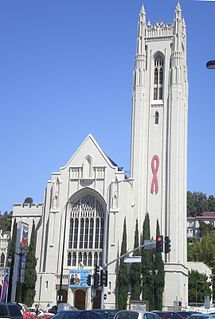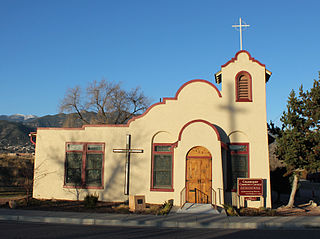
Chivington is an unincorporated community in Kiowa County, Colorado, United States. The U.S. Post Office at Eads now serves Chivington postal addresses.

The Lemon Bay Woman's Club is a historic woman's club in Englewood, Florida, United States. It is located at 51 North Maple Street. On August 11, 1988, it was added to the U.S. National Register of Historic Places.
The Lemon Bay Woman's club was organized by Dr. Mary Green who was a school teacher in Englewood. Originally named the Lemon Bay Mother's Club, a name retained until April 1924, the club played an important role in the development of the religious, educational, civic and political life of Englewood. Construction on the prairie style clubhouse was begun in September 1925 on two lots donated in Lampp subdivision by A. Stanley and Winifred E. Lampp. Englewood, incorporated in 1925, and the surrounding area then boasted 300 residents.
Sarasota architects Thomas Reed Martin and Clare C, Hosmer, formerly of Chicago, donated their design services for the building. Carpenters Pat Lampp, Fred Clark, and Leroy Bastedo were responsible for the clubhouse construction. The building originally consisted of a screened veranda and one large meeting room featuring a brick fireplace and a semi-circular stage, for which total construction cost was 3,120. A housewarming held on February 19, 1926, attracted 200 persons. Official incorporation, a year later, occurred under the direction of Charlotte Wellington, president.
In 1922, under the leadership of Mrs. Hallie Green, members started a school library and maintained a lending library at the club until 1962. Surviving the depression and the loss of its $37 treasury when banks failed, the club continued to hold fish fries, nature study classes, dances, card parties, plays, musical programs, travelogues and lectures. The club retired its mortgage on February 24, 1938. The note was burned at a gala meeting on March 4, 1938
Between 1926 and 1970, the club served as a sanctuary for many Englewood churches and as a meeting place for various organizations. The Englewood Community Church was the first congregation to meet at the club. Others included the Community Presbyterian Church, First Baptist Church, St. Raphael's Catholic Church, St. David's Episcopal Church, Evangelical Free Church, Church of God, Church of Christ, First Methodist Church, and Calvary Baptist Church. During World War II the building was turned over to the American Red Cross. The club was the first building in Englewood to be listed in the National Register of Historic Places.

Salem First United Methodist Church is a Methodist congregation and historic church in Salem, Oregon, United States. The church was listed on the National Register of Historic Places under its original name, First Methodist Episcopal Church of Salem, in 1983. First United is the oldest Methodist church west of the Rocky Mountains, and is a designated United Methodist Heritage Landmark. It is one of Oregon's few high-style Gothic Revival churches outside of Portland, and has one of the rare tall spires left standing in the state.

The old First Methodist Episcopal Church, also known as First Methodist Episcopal Church, South, is an historic redbrick Southern Methodist church building located at 400 Broadway in Pueblo, Colorado. Designed by George W. Roe in the Romanesque Revival style of architecture, it was built in 1902. In 1939 it became the Trinity Methodist Church. Bought by the George F McCarthy Funeral Home in 1954, it is now the George McCarthy Historic Chapel and is used for funeral services.

Cañon City Downtown Historic District is a historic district in Cañon City, Colorado. It was listed on the National Register of Historic Places in 1983. The historic district listing was based on a 1981 survey by city staff; a 2004-05 survey has been completed which updates and expands upon it.

St. Raphael's Church is a historic Catholic church in the city of Springfield, Ohio, United States. Established in the 1840s as Springfield's first Catholic parish, it uses a Gothic Revival church building, the towers of which hold a prominent spot in the city's skyline. As a work of a leading city architect, the building has been named a historic site.

Sharon Methodist Episcopal Church is located in Sharon Township, a rural area of northwest Clinton County, Iowa, United States. The building is the only remaining structure that remains of a community by the name of Burgess, which was nicknamed Smithtown. The building is commonly referred to as the Smithtown Church. It was listed on the National Register of Historic Places in 2003.

St. Paul's United Methodist Church is located in downtown Cedar Rapids, Iowa, United States. The Louis Sullivan-designed building has been individually listed on the National Register of Historic Places since 1985. In 2000 it was included as a contributing property in the Second and Third Avenue Historic District.

Thomas Pellatt Barber was an architect active in the Southwestern United States. Several of his works are listed on the U.S. National Register of Historic Places.

The American Legion Hall near Eads, Colorado was built during 1937-38 under the Works Progress Administration. It is a one-story 95 by 35 feet building that was listed on the National Register of Historic Places in 2007. Also known as Kiowa County Fairgrounds Community Building, it served as a meeting hall and was NRHP-listed for its architecture. According to its NRHP nomination, it is a "rare surviving example of a simple, vernacular building constructed by the WPA".

William Ellsworth Fisher was an architect who founded the Denver, Colorado firm that became Fisher & Fisher.

St. Henry's Catholic Church is a historic Catholic parish in the rural community of Harriettsville in the southeastern part of the U.S. state of Ohio. Established for German settlers in the 1860s, it worships in a landmark church building constructed in the 1890s. As the only stone building in the area and the work of a prominent architect, it has been named a historic site.

Dixboro United Methodist Church is a historic church located at 5221 Church Street in Dixboro, Michigan. It was added to the National Register of Historic Places in 1972 and designated a Michigan State Historic Site in 1971. It is significant as a nearly unaltered example of a mid-19th century Greek Revival-style church designed by a professional architect.

The First United Methodist Church is a historic United Methodist Church in Jasper, Walker County, Alabama. The congregation dates back to the 1830s. This building is their fifth, built from 1912–21. Architectural scholars consider this to be one of the best of its type in the state. It was added to the National Register of Historic Places on February 14, 1985.

Lenora Methodist Episcopal Church is a historic church in Lenora, Minnesota, United States, an unincorporated community in Canton Township, Fillmore County. It was added to the National Register of Historic Places in 1982.

The First Congregational Church in Colorado Springs, Colorado is a historic church at 20 East Saint Vrain Street. It was listed on the National Register of Historic Places in 2002.
Frederick Albert Hale was an American architect who practiced in states including Colorado, Utah, and Wyoming. According to a 1977 NRHP nomination for the Keith-O'Brien Building in Salt Lake City, "Hale worked mostly in the classical styles and seemed equally adept at Beaux-Arts Classicism, Neo-Classical Revival or Georgian Revival." He also employed Shingle and Queen Anne styles for several residential structures. A number of his works are listed on the U.S. National Register of Historic Places.

Black Forest School or Old Log School of Black Forest is a historic school in Black Forest, Colorado. It is a National Register of Historic Places listing and is one of the schools on a multiple submission of "Rural School Buildings in Colorado" for the Colorado State Register of Historic Properties.

The Chadbourn Spanish Gospel Mission is a Mission Revival building in the Conejos District of Colorado Springs, Colorado. The building is on the National Register of Historic Places.

The Eads School Gymnasium is a historic Mission Revival-style school gymnasium in Eads, Colorado. It was built in 1929 and listed on the National Register of Historic Places in 2013.


























